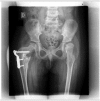Orthopaedic phenotyping of NGLY1 deficiency using an international, family-led disease registry
- PMID: 31217022
- PMCID: PMC6584998
- DOI: 10.1186/s13023-019-1131-4
Orthopaedic phenotyping of NGLY1 deficiency using an international, family-led disease registry
Abstract
Background: NGLY1 deficiency is a rare autosomal recessive disorder caused by loss in enzymatic function of NGLY1, a peptide N-glycanase that has been shown to play a role in endoplasmic reticulum associated degradation (ERAD). ERAD dysfunction has been implicated in other well-described proteinopathies, such as Alzheimer's disease, Parkinson's disease, and Huntington's disease. The classical clinical tetrad includes developmental delay, hypolacrima, transiently elevated transaminases, and hyperkinetic movement disorders. The musculoskeletal system is also commonly affected, but the orthopaedic phenotype has been incompletely characterized. Best practices for orthopaedic clinical care have not been elucidated and considerable variability has resulted from this lack of evidence base. Our study surveyed patients enrolled in an international registry for NGLY1 deficiency in order to characterize the orthopaedic manifestations, sequelae, and management.
Results: Our findings, encompassing the largest cohort for NGLY1 deficiency to date, detail levels of motor milestone achievement; physical exam findings; fracture rates/distribution; frequency of motor skill regression; non-pharmacologic and non-procedural interventions; pharmacologic therapies; and procedural interventions experienced by 29 participants. Regarding the orthopaedic phenotype, at time of survey response, we found that over 40% of patients experienced motor skill regression from their peak. Over 80% of patients had at least one orthopaedic diagnosis, and nearly two-thirds of the total had two or more. More than half of patients older than 6 years had sustained a fracture. Related to orthopaedic non-medical management, we found that 93 and 79% of patients had utilized physical therapy and non-operative orthoses, respectively. In turn, the vast majority took at least one medication (including for bone health and antispasmodic therapy). Finally, nearly half of patients had undergone an invasive procedure. Of those older than 6 years, two-thirds had one or more procedures. Stratification of these analyses by sex revealed distinctive differences in disease natural history and clinical management course.
Conclusions: These findings describing the orthopaedic natural history and standard of care in patients with NGLY1 deficiency can facilitate diagnosis, inform prognosis, and guide treatment recommendations in an evidence-based manner. Furthermore, the methodology is notable for its partnership with a disease-specific advocacy organization and may be generalizable to other rare disease populations. This study fills a void in the existing literature for this population and this methodology offers a precedent upon which future studies for rare diseases can build.
Keywords: Disease advocacy organizations; Disease registry; Evidence-based medicine; NGLY1 deficiency; Natural history; Orthopaedics; Standard of care.
Conflict of interest statement
The authors declare no competing interests.
Figures





Similar articles
-
Reversibility of motor dysfunction in the rat model of NGLY1 deficiency.Mol Brain. 2021 Jun 13;14(1):91. doi: 10.1186/s13041-021-00806-6. Mol Brain. 2021. PMID: 34120625 Free PMC article.
-
NGLY1 Deficiency, a Congenital Disorder of Deglycosylation: From Disease Gene Function to Pathophysiology.Cells. 2022 Mar 29;11(7):1155. doi: 10.3390/cells11071155. Cells. 2022. PMID: 35406718 Free PMC article. Review.
-
Ngly1 -/- rats develop neurodegenerative phenotypes and pathological abnormalities in their peripheral and central nervous systems.Hum Mol Genet. 2020 Jun 27;29(10):1635-1647. doi: 10.1093/hmg/ddaa059. Hum Mol Genet. 2020. PMID: 32259258 Free PMC article.
-
Transcriptome and functional analysis in a Drosophila model of NGLY1 deficiency provides insight into therapeutic approaches.Hum Mol Genet. 2018 Mar 15;27(6):1055-1066. doi: 10.1093/hmg/ddy026. Hum Mol Genet. 2018. PMID: 29346549 Free PMC article.
-
NGLY1 deficiency: Novel variants and literature review.Eur J Med Genet. 2021 Mar;64(3):104146. doi: 10.1016/j.ejmg.2021.104146. Epub 2021 Jan 23. Eur J Med Genet. 2021. PMID: 33497766 Review.
Cited by
-
Regulation of BMP4/Dpp retrotranslocation and signaling by deglycosylation.Elife. 2020 Jul 28;9:e55596. doi: 10.7554/eLife.55596. Elife. 2020. PMID: 32720893 Free PMC article.
-
NGLY1 Deficiency: A Rare Newly Described Condition with a Typical Presentation.Life (Basel). 2021 Feb 27;11(3):187. doi: 10.3390/life11030187. Life (Basel). 2021. PMID: 33673403 Free PMC article.
-
Reversibility of motor dysfunction in the rat model of NGLY1 deficiency.Mol Brain. 2021 Jun 13;14(1):91. doi: 10.1186/s13041-021-00806-6. Mol Brain. 2021. PMID: 34120625 Free PMC article.
-
NGLY1 Deficiency, a Congenital Disorder of Deglycosylation: From Disease Gene Function to Pathophysiology.Cells. 2022 Mar 29;11(7):1155. doi: 10.3390/cells11071155. Cells. 2022. PMID: 35406718 Free PMC article. Review.
-
NGLY1 deficiency: estimated incidence, clinical features, and genotypic spectrum from the NGLY1 Registry.Orphanet J Rare Dis. 2022 Dec 17;17(1):440. doi: 10.1186/s13023-022-02592-3. Orphanet J Rare Dis. 2022. PMID: 36528660 Free PMC article.
References
MeSH terms
Substances
Supplementary concepts
LinkOut - more resources
Full Text Sources

